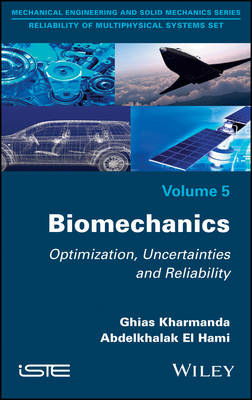
Biomechanics
ISTE Ltd and John Wiley & Sons Inc (Verlag)
978-1-78630-025-6 (ISBN)
Ghias KHARMANDA, Associate Professor (HDR Europ. Dr Eng) Prof. Dr.Abdelkhalak EL HAMI, Laboratoire d’Optimisation et Fiabilité en Mécanique des Structures, LOFIMS, INSA de Rouen, France
Preface xi
Introduction xiii
List of Abbreviations xvii
Chapter 1 Introduction to Structural Optimization 1
1.1 Introduction 1
1.2 History of structural optimization 2
1.3 Sizing optimization 4
1.3.1 Definition 4
1.3.2 First works in sizing optimization 4
1.3.3 Numerical application 5
1.4 Shape optimization 10
1.4.1 Definition 10
1.4.2 First works in shape optimization 11
1.4.3 Numerical application 12
1.5 Topology optimization 16
1.5.1 Definition 16
1.5.2 First works in topology optimization 17
1.5.3 Numerical application 18
1.6 Conclusion 21
Chapter 2 Integration of Structural Optimization into Biomechanics 23
2.1 Introduction 23
2.2 Integration of structural optimization into orthopedic prosthesis design 23
2.2.1 Structural optimization of the hip prosthesis 24
2.2.2 Sizing optimization of a 3D intervertebral disk prosthesis 42
2.3 Integration of structural optimization into orthodontic prosthesis design 47
2.3.1 Sizing optimization of a dental implant 47
2.3.2 Shape optimization of a mini-plate 49
2.4 Advanced integration of structural optimization into drilling surgery 52
2.4.1 Case of treatment of a crack with a single hole 53
2.4.2 Case of treatment of a crack with two holes 54
2.5 Conclusion 56
Chapter 3 Integration of Reliability into Structural Optimization 57
3.1 Introduction 57
3.2 Literature review of reliability-based optimization 58
3.3 Comparison between deterministic and reliability-based optimization 60
3.3.1 Deterministic optimization 61
3.3.2 Reliability-based optimization 63
3.4 Numerical application 64
3.4.1 Description and modeling of the studied problem 64
3.4.2 Numerical results 65
3.5 Approaches and strategies for reliability-based optimization 68
3.5.1 Mono-level approaches 68
3.5.2 Double-level approaches 68
3.5.3 Sequential decoupled approaches 68
3.6 Two points of view for developments of reliability-based optimization 69
3.6.1 Point of view of “Reliability” 69
3.6.2 Point of view of “Optimization” 70
3.6.3 Method efficiency 70
3.7 Philosophy of integration of the concept of reliability into structural optimization groups 72
3.8 Conclusion 73
Chapter 4 Reliability-based Design Optimization Model 75
4.1 Introduction 75
4.2 Classic method 76
4.2.1 Formulations 76
4.2.2 Optimality conditions 77
4.2.3 Algorithm 77
4.2.4 Advantages and disadvantages 79
4.3 Hybrid method 79
4.3.1 Formulation 79
4.3.2 Optimality conditions 82
4.3.3 Algorithm 84
4.3.4 Advantages and disadvantages 85
4.4 Improved hybrid method 86
4.4.1 Formulations 86
4.4.2 Optimality conditions 86
4.4.3 Algorithm 89
4.4.4 Advantages and disadvantages 90
4.5 Optimum safety factor method 91
4.5.1 Safety factor concept 91
4.5.2 Developments and optimality conditions 92
4.5.3 Algorithm 97
4.5.4 Advantages and disadvantages 98
4.6 Safest point method 98
4.6.1 Formulations 98
4.6.2 Algorithm 102
4.6.3 Advantages and disadvantages 104
4.7 Numerical applications 105
4.7.1 RBDO of a hook: CM and HM 105
4.7.2 RBDO of a triangular plate: HM & IHM 107
4.7.3 RBDO of a console beam (sandwich beam): HM and OSF 110
4.7.4 RBDO of an aircraft wing: HM & SP 113
4.8 Classification of the methods developed 115
4.8.1 Numerical methods 115
4.8.2 Semi-numerical methods 116
4.8.3 Comparison between the numerical- and semi-numerical methods 118
4.9 Conclusion 119
Chapter 5 Reliability-based Topology Optimization Model 121
5.1 Introduction 121
5.2 Formulation and algorithm for the RBTO model 122
5.2.1 Formulation 122
5.2.2 Algorithm 123
5.2.3 Validation of the RBTO code developed 125
5.3 Validation of the RBTO model 126
5.3.1 Analytical validation 126
5.3.2 Numerical validation 128
5.4 Variability of the reliability index 134
5.4.1 Example 1: MBB beam 136
5.4.2 Example 2: Cantilever beam 136
5.4.3 Example 3: Cantilever beam with double loads 136
5.4.4 Example 4: Cantilever beam with a transversal hole 136
5.5 Numerical applications for the RBTO model 137
5.5.1 Static analysis 138
5.5.2 Modal analysis 139
5.5.3 Fatigue analysis 141
5.6 Two points of view for integration of reliability into topology optimization 142
5.6.1 Point of view of “topology” 144
5.6.2 Point of view of “reliability” 144
5.6.3 Numerical applications for the two points of view 146
5.7 Conclusion 152
Chapter 6 Integration of Reliability and Structural Optimization into Prosthesis Design 153
6.1 Introduction 153
6.2 Prosthesis design 154
6.3 Integration of topology optimization into prosthesis design 154
6.3.1 Importance of topology optimization in prosthesis design 155
6.3.2 Place of topology optimization in the prosthesis design chain 156
6.4 Integration of reliability and structural optimization into hip prosthesis design 157
6.4.1 Numerical application of the deterministic approach 158
6.4.2 Numerical application of the reliability-based approach 167
6.5 Integration of reliability and structural optimization into the design of mini-plate systems used to treat fractured mandibles 174
6.5.1 Numerical application of the deterministic approach 174
6.5.2 Numerical application of the reliability-based approach 181
6.6 Integration of reliability and structural optimization into dental implant design 184
6.6.1 Description and modeling of the problem 184
6.6.2 Numerical results 186
6.7 Conclusion 188
Appendices 189
Appendix 1 ANSYS Code for Stem Geometry 191
Appendix 2 ANSYS Code for Mini-Plate Geometry 197
Appendix 3 ANSYS Code for Dental Implant Geometry 201
Appendix 4 ANSYS Code for Geometry of Dental Implant with Bone 207
Bibliography 213
Index 229
| Erscheinungsdatum | 19.01.2017 |
|---|---|
| Verlagsort | London |
| Sprache | englisch |
| Maße | 66 x 109 mm |
| Gewicht | 454 g |
| Themenwelt | Medizin / Pharmazie ► Physiotherapie / Ergotherapie ► Orthopädie |
| Studium ► 1. Studienabschnitt (Vorklinik) ► Physiologie | |
| Technik ► Medizintechnik | |
| Technik ► Umwelttechnik / Biotechnologie | |
| ISBN-10 | 1-78630-025-7 / 1786300257 |
| ISBN-13 | 978-1-78630-025-6 / 9781786300256 |
| Zustand | Neuware |
| Haben Sie eine Frage zum Produkt? |
aus dem Bereich


